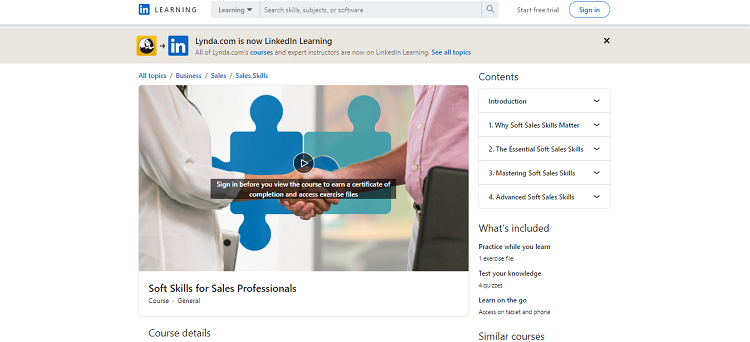Lesson 4: How you can master soft sales skills
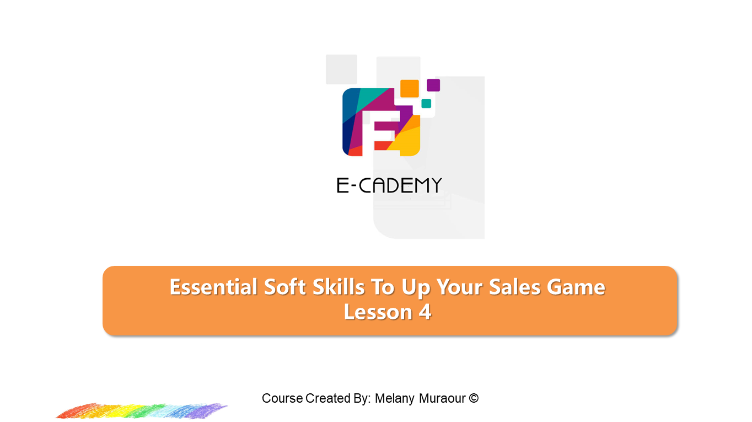
Let’s Get Started!
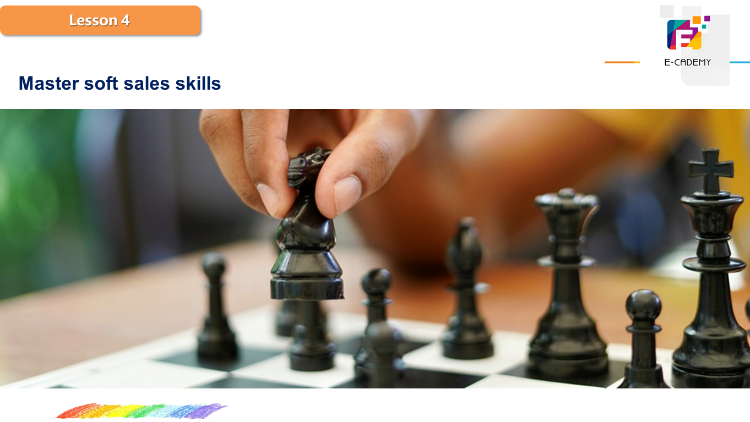
Mastering soft sales skills
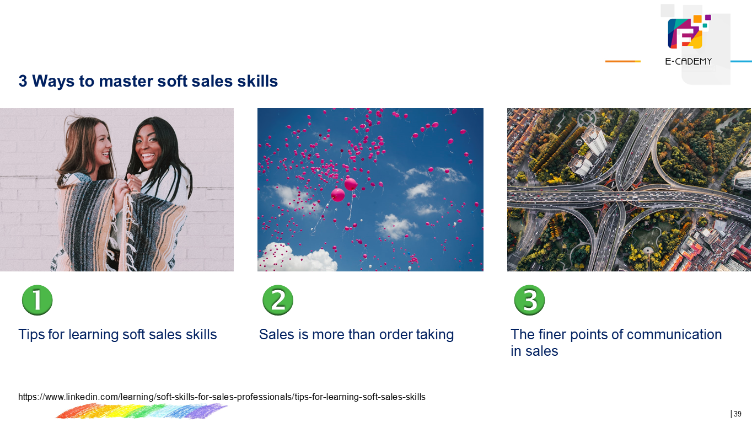
1. Tips for learning soft sales skills
In sales, we most often train the hard skills because they are easier to wrap our heads around. And while some sales professionals have more of a natural tendency towards soft skills, the truth is no matter your level of natural talent, soft skills can be learned. However, the best place to start when learning soft skills is to understand which of those skills best applies to your role in sales. Understanding which soft skills are a priority will ensure you focus on the right and most effective skills first. With each soft skill you choose to focus on, you want to learn why it matters, why it’s important, and why and how it will impact the outcome of your sale.
Setting up scenarios, giving you an opportunity to put your soft skills into action in an environment where you can truly work on developing them will do a lot to build your soft skills. Designing role-plays that give you the opportunity to practice the skill and get feedback from your team members will dramatically increase the speed at which your soft skills develop.
Just like we use tools in school to get better at learning to spell or solving math problems, you can use tools to improve your soft skills. Creating flashcards for conversation starters, customer problems, listening skills, are tools you can used to get you to think on your feet, tap into your soft skills knowledge base, and make you feel just like you are in the middle of a customer sales call. The more you practice soft skills, the stronger you will be at these critical skills that can dramatically increase your ability to close more sales.
2. Sales is more than order-taking
Sales is so much more than order taking. You need to really think through what your customers are telling you, and analyse their unique situation. Don’t let a lack of critical thinking be the missing piece in your sales puzzle.
You start with a few pieces, your products, and services, and then you engage with a customer and you get a few more; the details of their businesses, their biggest challenges, and a few of their opportunities. Your goal is to find a way to fit the pieces you have together, so you can ultimately solve the puzzle and make the sale. But to solve this puzzle, you need a framework. You can think of this framework as the edges of the puzzle. It’s going to make putting all the pieces together a lot easier.
So what exactly is the framework? It’s your critical thinking and problem-solving skills.
You can have all the product knowledge in the world, but if you can’t think your way through how to use those resources to solve customer problems, you’ll never really add value and personalise a sale. Sales would be so easy if every customer had the same problems, but you know that’ll never be the case. Every customer, even those within the same industry, has a different story, a different set of challenges, and they need a different mix of solutions, so you need to be ready to analyse each situation and tailor a unique solution that works for them.
Let’s break down what you could do, if, say you’re a loan consultant…
First, ask questions to find out why your client wants to borrow money, and what was driving their need to borrow. Starts with some courageous, open-ended, and then drill-down questions.
Then… just listen. this will give you an opportunity to analyse what is actually being said, rather than taking the conversation somewhere it doesn’t need to go.
Next, clarify your understanding by sharing back what you heard.
This will help achieve 2 things. One, you will be able to confirm that he did hear all of your client’s plans for the loan, and two, he showed the client that they were heard. Clarifying is an important trust-building technique, and this is what you’re going to need to win your client over with your proposed solution.
Finally, you need to create and explain the alternative solutions. For example, the solution can be split into two parts – a loan and/or a line of credit; this gives your client a choice.
It’s important your customer feels some ownership in the sale. Providing multiple choices or a two-part solution like the one above is a great way to achieve this. And, if you haven’t had much practice at this, and you can’t think up an alternative on the spot, tell the customer you want to brainstorm a solution with your crew. Just make sure you set up that next meeting with your client and follow through.
3. The finer points of communication in sales
If you can not get your customers to talk to you or get them to open up, share information, and relate in a way that helps you get to the root of their problems, their fears, and their biggest challenges, then you will never be able to sell to them. The better your communication skills, the easier and more effective the process is going to be.
Mastering things like understanding your own communication style, the communication style of your customer, being present and fully engaged will all be invaluable in helping you build the relationship and close the deal. It seems like common sense that you would need strong communication skills to be good at sales, but while it may be common sense to be good at communication, it’s not always clear what that means. Communication is a word that is overused and more than often misunderstood, especially when it comes to sales. We often think communication is about telling information to people when in reality, communication is more about having your customers tell things to you.
Here are strategies you can use to improve your sales communication skills:
Pay full attention
Be present. One of the greatest pieces of sales advice is to “pay full attention” meaning that when your customer is talking, do not be thinking about what you are going to say or what you said 10 minutes ago. Be in the moment and really listen. If and when you do that, your customer feels important, and you’re able to tap into your intuitive communication skills that will ensure you gather all the information you need to provide the best answers and solutions for your customer.
Practice active listening
Active listening involves eye contact, focus, and the ability to really hear what your customer is saying. When you actively listen, you are able to easily repeat and clarify what your prospect said, ask relevant follow-up questions and, keep the information/conversation flowing.
Understand tone and body language, and all the other clues of what is not being said or communicated in words
Your customers tell you so much just by the tone of their voice or the movement of their bodies. Pay attention and learn to read the clues. If they’re looking around instead of looking at you, they may be bored or uninterested. If they fold their arms to sit back in their chair, they may be looking for ways to shut the conversation down. So be open, be aware, and look for and understand their nonverbal cues.
Recalculate
The best communicator in the world is the GPS system in your car or on your phone because they assume they just need to adjust their communication style to better fit yours. A GPS never yells at you, it never tells you the same thing twice and even if you do not understand what they are saying, they just “recalculate,”, adjust their message, and share it with you in a different way, one which you can eventually understand.
Use the power of story
Examples, anecdotes, and stories are some of the most powerful ways to communicate with anyone. Your customers relate to them, more easily understand them, and most importantly, can remember them. So find ways to add stories and examples in your sales calls and presentations. Communication is a two-way street, and yes, you want to be effective at getting your message across, it’s also important to ensure you are just as attuned to receiving your customer’s message.
Download Extra Notes
“Soft Skills for Sales Professionals”
For extra reading, click on the image below or click here to get the PDF links to the Course “ Soft Skills for Sales Professionals” by Meridith Powell on LinkedIn Learning.
Summary
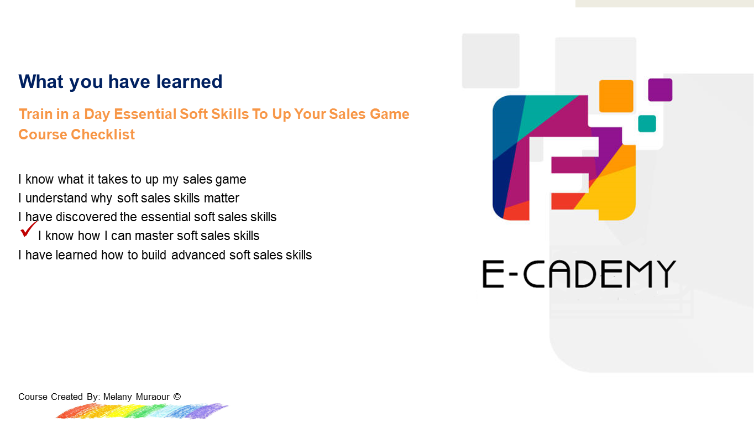
Still to Follow
- How you can build advanced soft sales skills

